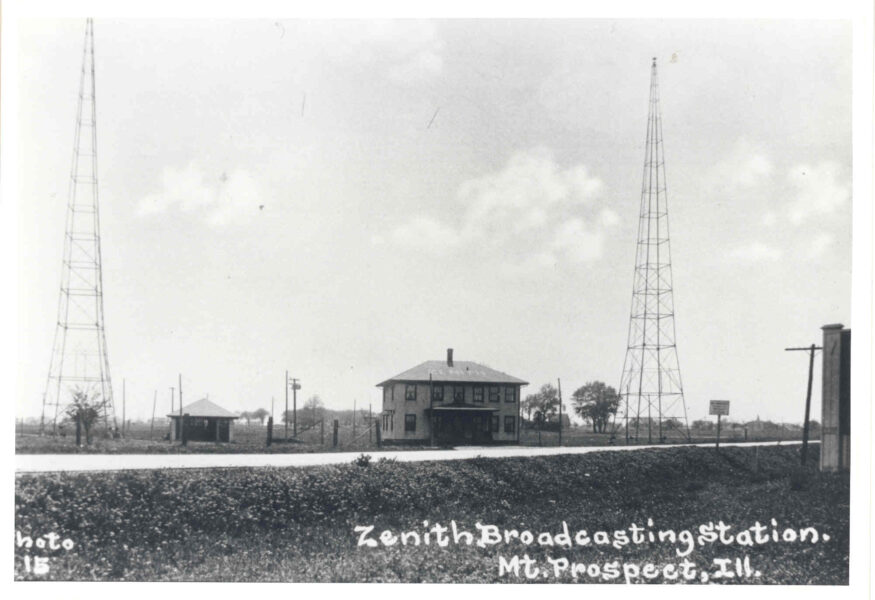
Ask any Mount Prospect long-timer and one of the most universal local memories they have is of the pair of Zenith Radio towers that once stood at the corner of Central and Rand Roads. Constructed in 1925 by Zenith for its WJAZ radio station, they were a fixture in the community for almost 50 years.
WJAZ began broadcasting from the Edgewater Beach Hotel in Chicago in 1923. One of its faithful listeners in those early years was Col. Robert R. McCormick, publisher of the Chicago Tribune. He heard the WJAZ broadcasts and became interested in the power of radio. He even began to lease large time slots on WJAZ.
Simultaneously, McCormick reserved the call letters WGN, which stood for World’s Greatest Newspaper, with plans to start his own station. Before long, McCormick bought the WJAZ studio and began broadcasting WGN programming from there. The Zenith Radio Corp. retained the call letters WJAZ.
Even before selling its studio, Zenith had expressed an interest in moving to a more isolated area because of interference with other radio stations in Chicago. First, the company built a portable station inside of a truck so it could broadcast live at events across the country. It could be set up in the middle of a field and could operate on self-sustained power. That was how it became the first radio station to broadcast the MGM lion from Gay’s Lion Farm in California.
While using the portable station, WJAZ visited approximately 50 communities in a 150-mile radius of Chicago, testing for interference levels. That is how they settled on Mount Prospect for a permanent location. Since it was still only farmland and boasted the highest point in Cook County, it proved to be the perfect location. In 1925, George Busse sold his land on the corner of Central and Rand Roads to Zenith, and it became the new home of WJAZ.
The studio was operated by Gilbert Gustafson from 1925 to 1935. The broadcasting station was located inside a two-story farmhouse that was situated between the two radio transmission towers. The station ran on 5,000 watts of power, and its transmitter was water-cooled. Each tower had an antennae and a 1,000-watt light bulb at its tip. The word “Zenith” was arranged down one of the radio towers and glowed red at night. These towers could be seen from miles away.
The building and transmitter were designed by J. Elliot Jenkins, who was considered one of the finest radio engineers in the country. The second floor of the house was used as living quarters for the Gustafson family, and the first floor held the transmitter room, motor, generator room and studio.
Zenith’s WJAZ not only developed new innovations for the industry, it also tested the legal boundaries of radio broadcasting and created quite a stir when it ignored the authority of the U.S. Department of Commerce. The DOC had forced WJAZ to share a wave length with another station, allowing it only two hours of air time per week, while the other station, KOA, was allotted 166 hours per week. Because of the unfair arrangement, WJAZ began using an unoccupied Canadian wave length. The government charged WJAZ with piracy of the free air but the courts found WJAZ innocent, due to the lack of legal authority. The Radio Act of 1912 was not enough to charge WJAZ with piracy or any other violation.
Found in the archives of the Mount Prospect Historical Society are two photographs that show the radio operators and assistants of the Zenith Broadcasting Station dressed up as pirates. It is unknown whether this was a photo taken of a live pirate show or if it was taken to mock the accusations against WJAZ as being “pirates of the air.” Does anyone know?
Zenith Radio Corp. continued to own the Mount Prospect property and had it looked after by a caretaker. The towers and building were eventually torn down in the 1970s to make room for commercial development. Although the towers are long gone, the memory of this one-time landmark still beats in the heart of Mount Prospect.
This article originally appeared in the Summer 2014 Mount Prospect Historical Society Museum Journal newsletter, Volume V, Issue 2. It was revised in November 2021 to correct content.